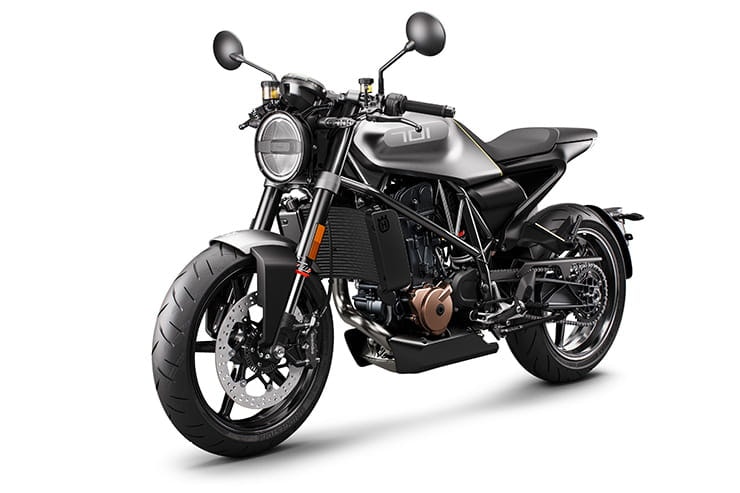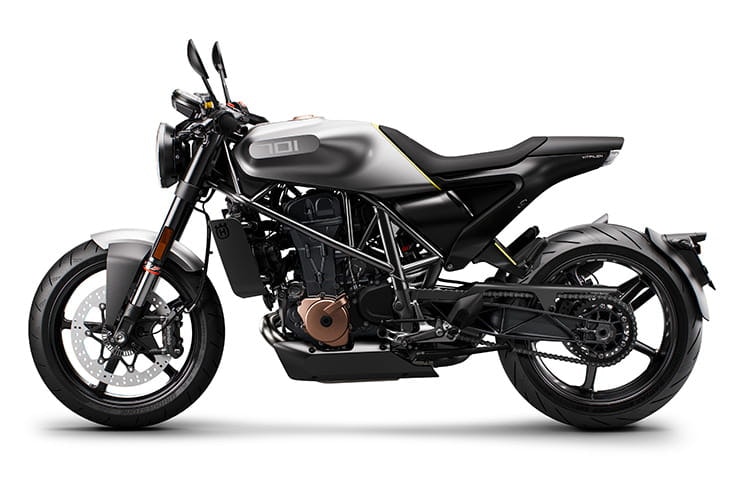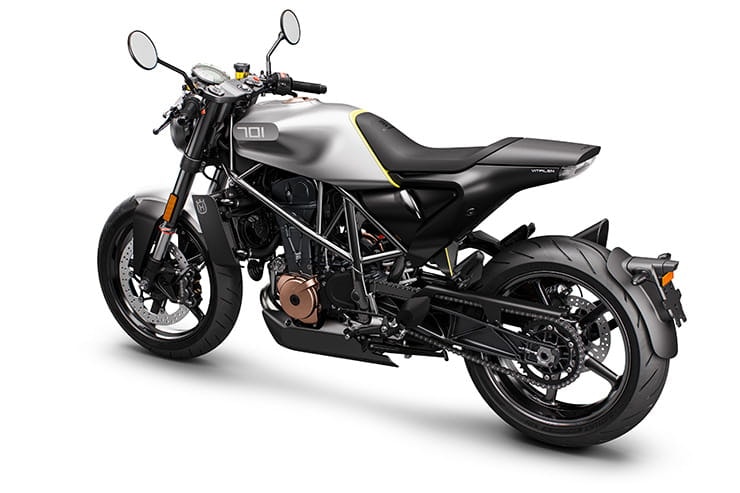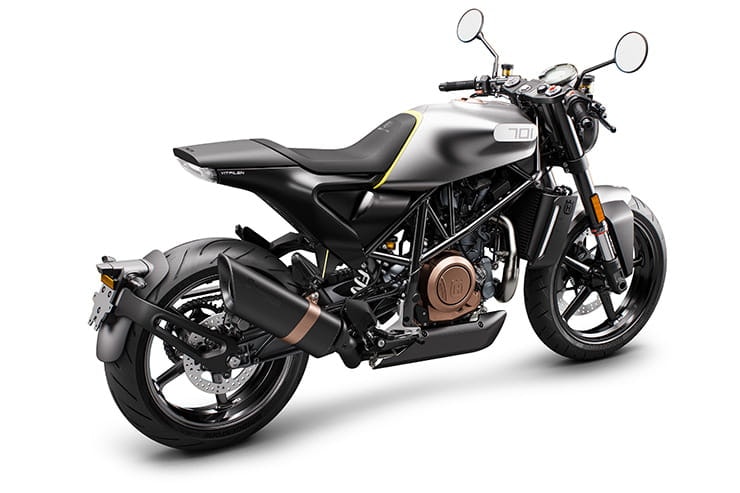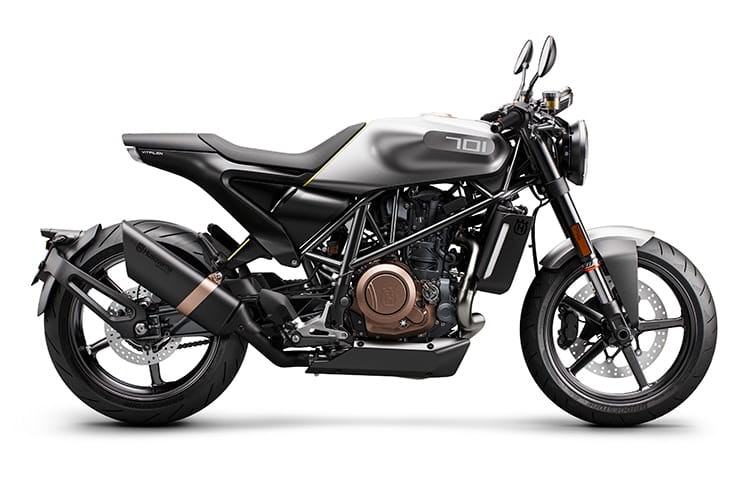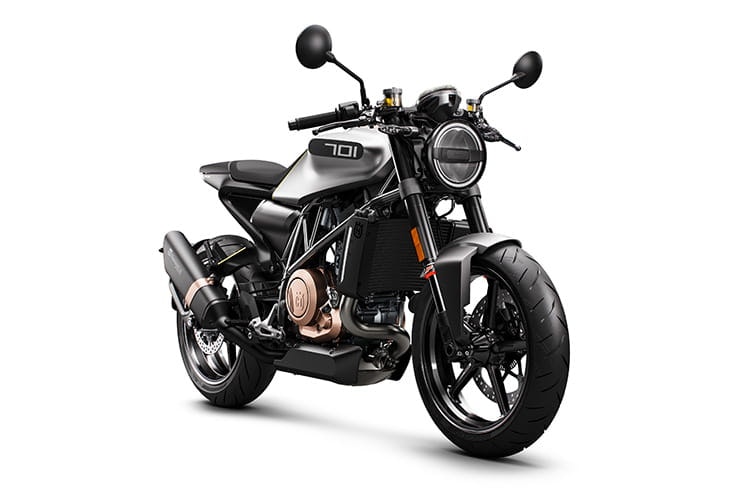Husqvarna Vitpilen 701 (2018) - Review
By John Milbank
Consumer Editor of Bennetts BikeSocial
22.03.2018
KIT CREDITS
Helmet
Arai Quantum ST: From £350 | www.whyarai.co.uk
Jacket
Segura Retro Brown jacket: £399.99 | www.tranam.co.uk
Jeans
Hood jeans: From £95.99 | www.hoodjeans.co.uk
Boots
TCX Street Ace (waterproof): £124.99 | www.nevis.uk.com
Gloves
Racer High Speed: £189.99 | www.tranam.co.uk
Described as a “new gateway to motorcycle culture”, and promising to “make urban motorcycling more accessible to anyone who chooses to ride”, the Husqvarna 701 Vitpilen is a naked street bike designed to appeal to a style-conscious audience.
The engine is the most powerful single-cylinder production motor currently available, the trellis frame is well matched to high-quality WP suspension, and the overall design presents a bike that’s far more emotive than many other modern motorcycles.
Don’t mistake this for a fancy-looking bike that doesn’t work; it’s based on the brilliant KTM 690 Duke platform, so shares years of performance and handling development. It’s an exercise in design, but it’s certainly not at the expense of function…
Price
At its launch, the Husqvarna costs £8,899 – £900 more than the established KTM 690 Duke upon which it’s based. Components are of a very high standard, and there are extra features over the Duke, but the target market will likely be enamoured enough with the bold styling to feel it’s a price worth paying.
Power and torque
Making 73.8bhp @ 8,500rpm and 53.1lb-ft @ 6,750rpm, the Husqvarna – as you’d expect – gives very similar performance to the 690 Duke; the KTM produces 54.6lb-ft at a slightly earlier 6,500rpm and hits its peak of 72.4bhp 500rpm sooner, at 8,000rpm.
These small differences compared to the 690 Duke are due to the redesigned airbox (to fit under the new tank), new exhaust, and an ECU remap to suit the air flow. I’m told the slight increase in power definitely wasn’t engineered to give the 701 bragging rights over its orange sibling.
74bhp might seem relatively tame, but in such a relatively lightweight machine, and given that it’s not designed for flat-out track use or autobahn touring, it’s more than enough to be thoroughly enjoyable, and certainly capable of way over 100mph.
Engine, gearbox and exhaust
Personally, I think there are far too few big single-cylinder motors left in biking. The 692.7cc, twin-spark, liquid-cooled four-valve over-head cam engine in the Husqvarna (which weighs just 43.4kg) has the characterful surge of a big thumper, but – incredibly – none of the vibration of those big mono-pots of old. Under 3,000rpm it does get shakey, but beyond that it’s all drive.
Dual balancer shafts – one on the crank and one on the cam – and a high revving nature make this motor extremely easy to use, without spoiling the feel and bark that makes this such a great configuration. Forget the notion that more cylinders = better: bikes are all about the way each one makes you feel, and a single feels a lot different to a V-twin, and especially to a parallel-twin or four.
The fuelling is typical Austrian – very well set up, with no flat spots or glitchy pick-up from a closed throttle. There isn’t much engine braking at all, which is good in that weight isn’t slung to the front of the bike if you shut off quickly, but it did catch me out on one corner as the bike kept rolling more easily than I expected.
The exhaust is fully stainless steel, while the paint on the end-can and connector pipe is heat-resistant. As you’d expect, given that it can reach temperatures of 350°C at some points. Servicing is every 12months / 10,000km (6,000miles).
Economy
Husqvarna claims the 701 can return 80.7mpg – with its 12litre tank, that could mean a range of up to 213miles. On the launch though, which did see a lot of stop-start and aggressive riding, I got 54mpg – still a decent figure, but one that’ll mean 142 miles at best. Realistically, you’ll probably be looking for fuel after about 120miles.
The best economy seen by a UK rider on the launch was 60mpg (158miles max), and having ridden the 690 Duke around my favourite roads, I know these are pretty realistic figures (I got 56.6mpg riding that enthusiastically).
Handling, suspension, chassis and weight
The Vitpilen 701 carries its motor in a high-gloss powder-coated chromium-molybdenum steel trellis frame, supported by 43mm upside-down WP forks (adjustable from the top for compression and rebound damping) and a single WP monoshock (adjustable for preload and rebound damping) linked to a cast aluminium swingarm.
Hydroformed then welded by robot, the main frame weighs just 11kg, while the subframe is cast aluminium, and forms the wonderfully elegant rear end – those sweeping lines really are structural.
Compared to the KTM 690 Duke, the front end is lower and the rear is higher. In the city, the 701 feels very light (because it is), and extremely nimble; the turning circle is excellent, so it’s ridiculously easy to spin around in the road. Out in the countryside the bike tips into corners without fuss, and feels precise as the pace quickens. Deliberately nudging the clip-on style bars (which sprout from sides of the aluminium top triple clamp) on the motorway doesn’t see the bike want to get into a weave, though the relatively small mass does seem to help towards the front feeling more lively than a bigger machine.
On our dry test route I found the Bridgestone S21 rubber to be fine, though one much faster journalist did comment that he thought they were lacking in grip. While I was riding at a very ‘spirited’ pace, he was pushing much harder.
Brakes
A single 320mm disc up front is bitten by a radially-mounted four-piston Brembo caliper with a radial cylinder. On the rear, a single-pot sliding Brembo works on a 240mm disc.
ABS is of course standard – as it now is on any new bike over 125cc – but it is switchable, meaning you can completely turn it off if you want the ‘authentic’ feel of an old-school machine. Though why you’d want to turn off the high-quality, unobtrusive Bosch system is beyond me. If you must, the bike has to be stationary before you hold the mode button and the blank button below it for a few seconds. It’ll come back on the next time you start the bike.
The brakes are progressive in bite and plenty firm enough for a motorcycle of this weight and power – I had to scrub off more speed than I realised a couple of times, but the precise feel made it easy to regulate the anchor, and I was conscious of being able to just fractionally brake a little harder – or let off a little – even deep into a corner.
The levers are relatively short on the 701, but I never once felt I needed more than the three fingers you can fit across the right-hand control.
Comfort
At 830mm, the seat’s significantly higher than a Yamaha MT-07 for instance, at 805mm. I’m 5’10”, and could still get my feet flat on the floor when stopped, but the wide and sharp-edged design of the saddle means it’s not a comfortable position.
I wasn’t the only one to comment on this, but nobody complained that the 701 was too tall, and we generally agreed that, once riding it, any niggles disappear – the bars and pegs add to a very easy-going triangle that doesn’t cause cramped legs or a stretch over the heavily-sculpted tank.
Despite being a naked machine, the fact you’re not sat upright, like a sail, means that motorway speeds and above aren’t hard work. And while a passenger has nothing to hang onto at the rear (a strap is included to meet homologation, but wasn’t fitted to our test bikes as it doesn’t look cool), the pillion seat is surprisingly supportive and spacious – I wasn’t cramped on the back, and it’s certainly a far more relaxing perch than a sports bike.
Equipment
The Vitpilen’s marketing mantra is ‘Simple. Progressive.’ and while there’s plenty of tech on board, it doesn’t interfere. The ABS is a good example, but so too is the traction control; again, you can turn it off, but as my wheelie days are long gone, I didn’t bother. It can be deactivated while you’re riding, but you need to have the throttle shut and hold the blank, firm button on the dash for a few seconds to do it – it’s a lot easier when you’re at a standstill.
There are no riding modes to think about (simple) and an up and down ‘Easy Shifter’ is fitted as standard (progressive). It’s a marketing name for a quick-shifter, and is built into the engine case on the right, with a modified selector shaft running through from the left (so no, you can’t retro-fit it to a 690 Duke). Pushing up on the lever sees the engine cut momentarily as the next cog is selected – it works smoothly and cleanly. Press down on the lever and the engine’s speed is imperceptibly tweaked as the next lower gear engages. Of course, having a slipper clutch helps level things out here, but the main point to know is that it works at its best when you’re smooth with the action; that’s not to say you have to ride slowly, but try to stamp down quickly as you would when the clutch is engaged, and it feels too much like gearbox abuse. Think ahead, press down easily, and the selector works very well (and it still takes less time than pulling the clutch, changing gear, then letting the clutch out again).
I should point out that I accidentally found a false neutral going from fifth to sixth on the motorway using the easy shifter, and was able to replicate it by being a little too gentle in my up-changes (I could do it from fourth to fifth too). Keeping a positive motion to the changes eliminated this, so don’t be too slow or delicate.
There are no spurious buttons to clutter up the bar-mounted controls – just the ‘mode’, ‘set’ and blank buttons on the clocks (simple). Honestly, I’d prefer a switch within thumb’s reach, and the overly large, round digital dash doesn’t seem to fit with the beautifully considered styling of the rest of the bike. I guess an analogue dash wouldn’t be progressive enough, but this thing just looks cheap to me. Having said that, others might love it, and as design can be such a personal thing, I’m not going to criticise.
The adhesive vinyl ‘701’ logos on the tank jar for me too – a gloss lacquer over the lot wouldn’t have been to style, so I’d have preferred to see these painted on, or even moulded in to the surrounding plastic.
There’s a reasonable amount of info on the dash, but the clear plastic cover with visible mounting lugs can catch the sun, and the small digital display inside isn’t the easiest to read. The essentials are clear enough though, and besides the usual warning lights around the outside, you’ll be able to see revs, speed, gear, fuel level, coolant temperature, time and one of two trips. Additionally you can scroll through time to service, odometer, fuel range as well as average speed and average economy for each of the trips.
The mirrors are very vibey, making it hard to see what’s coming as you join a motorway, but more of a niggle is the short clutch lever; while the brake is okay, when the left lever is pulled all the way to the bars it feels like there’s not enough to hang onto, and that if it wasn’t for the protective ball on the end, your hand would slip off. You could move the master cylinder’s bracket (which also carries the mirror) about a centimetre closer to the grip, which would help, but ultimately the light-action advantage of a hydraulic clutch is lost by a lack of leverage in only having space for two fingers by the time the lever’s fully back.
The seat can be removed with the key to reach the battery, but there’s no storage space. Though with the seat off, it is possible to pull the pillion seat out (with tail lamp attached), which exposes a small area to tuck things in.
There’s no real space under the rider’s seat, but you can access the battery without tools
Design
I was fortunate enough to see the 701 in its very early form at KTM and Husqvarna’s design studio, Kiska. Always intended to be based on the Duke platform, it’s great to see that the bike still holds its core design principals, like the distinctive diagonal yellow slash, even if it isn’t quite as bold as the first design.
Husqvarna says this is a ‘timeless bike that reflects the progressive attitude and styling of a more modern and free-thinking breed of rider’. However the design team wants to word it, if this motorcycle fires up more people to get into biking, then it’s a real winner.
It’s not in the official catalogue, but we love this open airbox design
Like any bike, there’s scope for modification, and the open-airbox version we saw, with an exposed K&N cone air filter and full Akrapovič exhaust system looked fantastic. Sadly, homologation laws mean Husqvarna will not be building the modified plastic airbox parts, but with any luck an aftermarket manufacturer might step up…
Spoked wheels are in the catalogue, as are bar-end mirrors, luggage, machined footpegs, a ‘style’ seat and a traditional number plate carrier that hangs from the tail and replaces the floating rear mudguard/carrier.
Soft luggage is one of the optional extras available
2018 Husqvarna 701 Vitpilen verdict
KTM is passionate about its ‘ready to race’ brand identity, so while the Husqvarna is a 690 Duke at its core, the 701 Vitpilen is a machine that could never have been orange. By taking on the Husqvarna name, a new avenue has opened up to produce bikes that make great use of an extremely solid platform, but can have their own very unique style and riding character.
Comparing it to the 690 Duke, which doesn’t have a quick(easy)-shifter, but does have a colour TFT dash, it looks expensive. You might think about comparing it to the 690 Duke R, which has similar suspension, though that also has brilliant cornering ABS for £9,099.
Really, you shouldn’t be comparing the Husqvarna 701 Vitpilen to anything. For a start, it’s uniquely styled, and for another thing, that’s the last way any of us should buy a bike. Forget specs and comparisons; decide what you can afford, then buy with your heart.
Three things I loved about the Husqvarna 701 Vitpilen …
• Fantastic single-cylinder motor
• Light and easy to chuck about
• Very distinctive styling
Three things that I didn’t…
• Dash looks like the designer ran out of time
• Clutch lever too short
• No storage for a lock
Did you know?
Husqvarna is a village in Sweden, where in 1689 a weapons manufacturer started production, going on to produce sewing machines and agricultural tools in the late 1800s. This became Husqvarna in 1903, its street bikes soon competing in various road races. But it was Europe’s damaged post-war road network, and 1950s off-road motorsport that saw the company’s lightweight single-cylinder off-roaders gain popularity.
Husqvarna was bought by KTM in October 2013, following a difficult period that saw it passed between BMW, Cagiva MV Agusta and Electrolux. When Husqvarna was moved to Italy in 1988, most of the team stayed in Sweden to make enduro bikes under the name Husaberg.
The three blocks on the top of the logo represent a gun’s iron sites, harking back to the first days of manufacture…
2018 Husqvarna 701 Vitpilen specification
Contact www.husqvarna-motorcycles.com/gb
To insure this bike, click here
A quick look around the new bike
Take a look at the details of Husqvarna’s new 701 Vitpilen
